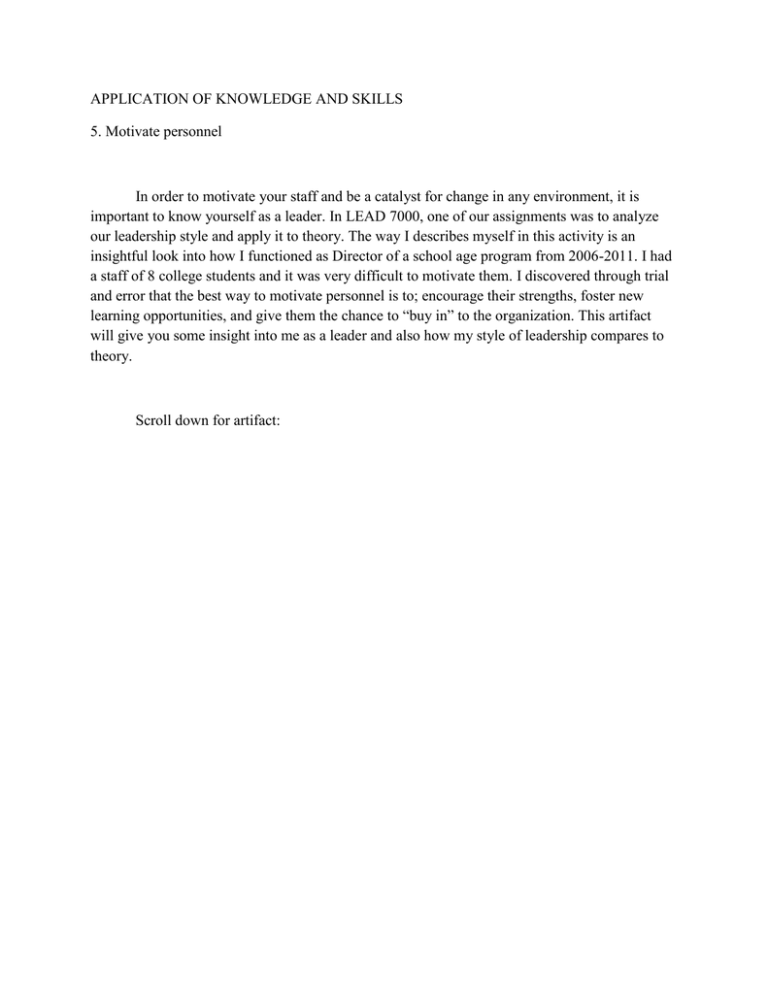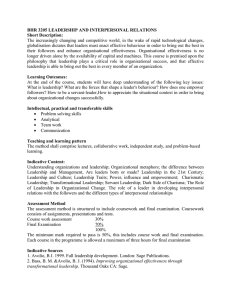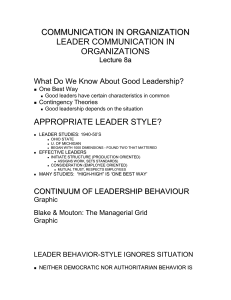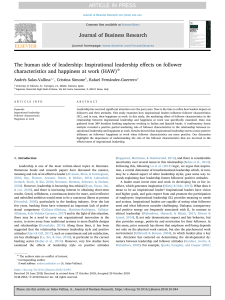5. lead 7000 leadership - Leadership Portfolio by Dawn Kimble
advertisement

APPLICATION OF KNOWLEDGE AND SKILLS 5. Motivate personnel In order to motivate your staff and be a catalyst for change in any environment, it is important to know yourself as a leader. In LEAD 7000, one of our assignments was to analyze our leadership style and apply it to theory. The way I describes myself in this activity is an insightful look into how I functioned as Director of a school age program from 2006-2011. I had a staff of 8 college students and it was very difficult to motivate them. I discovered through trial and error that the best way to motivate personnel is to; encourage their strengths, foster new learning opportunities, and give them the chance to “buy in” to the organization. This artifact will give you some insight into me as a leader and also how my style of leadership compares to theory. Scroll down for artifact: Leadership Theory and Practice Dawn Kimble Midterm LEAD 7000 My own leadership approach is most closely related to the skills approach in leadership, but would also incorporate aspects of other theories. My theory, like the skills approach, focuses on developing the skills of a leader to insure effectiveness at the individual’s present level of leadership. The skills approach in leadership focuses on characteristics that can be learned and developed. It was developed to explain the skills needed to be an effective leader. Although it is a leader centered perspective, it does emphasis knowledge and abilities as integral for effective leadership. This approach is divided into two parts with three basic skills: technical (knowledge about and proficiency in a type of work), human (the ability to work with people), and conceptual (the ability to work with ideas and concepts). Dawn’s approach would involve reevaluation and continued education in order to continue leadership growth and development and unlike the skills approach, that was been used on military personnel, my approach would also incorporate aspects of the situational approach because it shows how leaders should act in order to be more effective, and aspects of transformational leadership because” transformational leadership treats leadership as a process between leaders and followers, it provides a broad view of leadership that augments other leadership styles, and it places a strong emphasis on followers’ needs, values, and morals.”(Northhouse 2009) 2. The trait approach in leadership and the contingency theory are both very valuable theories that have added to the foundation of what leadership is today. They both have very valid views of leadership but slightly different explanations of what is important for a leader. One only views the trait of a leader as beneficial to organizations where as the other examines leadership from a situational point of view. The trait approach does not consider the followers or the situation as contributors. It focuses on a leader as being gifted with a certain number of important traits which ensure his capabilities as a leader. This theory is an integral part of the foundation of leadership, but fails to address leader/follower interactions or situations in leadership. It provides a basis for the characteristics that are most prominent in great leaders and it has also given organizations guidelines for selecting great leaders. This approach has also provided a starting point from which to study leadership and also to consider other factors that contribute to leadership The contingency theory shifts the focus of leadership from an individual focus to looking at leadership as a relationship between the leader and a situation. Based on Fiedler’s (1964, 1967; Fiedler & Garcia, 1987) theory, the contingency theory is defined as a leader-matched theory. Unlike trait theory, it does address the interactions of a leader in different situations not just the characteristics of that leader. This movement in leadership addresses the fact that leadership is not just about one individual and opens the study to the possibility of other relationships in leadership. One of the negative aspects of this theory is that like the trait approach, it does not consider leader/follower interactions and it only addresses a leader’s skill in certain situations. That means that this theory functions under the premise that a leader’s effectiveness is based on matching their skills with appropriate situations. 3. I would use transformational leadership as a basis for change in an organization. This theory incorporates and uses emotions, values, ethics, standards, and long term goals as a way to transform and influence people. When evaluating a dysfunctional organization, a leader will discover that the difficulties that any organization faces will fall in one of these categories. By examining and addressing the issues, transformational leadership can be a useful tool in addressing, staff/ follower issues, leadership deficiencies, and organizational culture. Bass and Avolio (1990a) suggest that transformational leadership can be taught to people at all levels in an organization and that it can positively affect a firm’s performance. It can be used in recruitment, selection, and promotion, and training and development. It can be used in improving team development, decision-making groups, quality initiatives, and reorganizations (Bass and Avolio, 1994). This theory is one of the few theories that, in addition to leader skills, address follower issues as an integral part of leadership. Transformational leadership assesses followers’ motives, finds ways to satisfy their needs and treats them as full human beings. This theory separates leader-follower interactions into factors that can be examined and used to improve various aspects of an organization. The five factors include; (1.) Idealized Influence which explains followers identifying and wanting to emulate leaders, (2.) Inspirational Motivation which describes the high expectations of leaders for their followers, (3.) Intellectual Stimulation the factor which includes leadership that stimulates a follower to be creative and innovative, and (4.) Individualized Consideration which represents leaders who provide a supportive environment and listen to the individual needs of their followers. Northhouse(p.172) states that transformational leadership is a process whereby a person engages with others and creates a connection that raises the level of motivation and morality in both the leader and the follower. Bass (1985,p.20) argued that Transformational leadership motivates followers to do more than expected by(a) raising followers levels of consciousness about the importance and value of specified and idealized goals,(b) getting followers to transcend their own self-interest for the sake of the team or organization, and (c)moving followers to address higher-level needs. Because transformational leadership “requires leaders to be aware of how their own behavior relates to the needs of their subordinates and the changing dynamics within their organization”, this is the best theory for reorganizing or addressing issues in a dysfunctional organization. Resources Northouse, Peter (2009) Leadership: Theory and Practice, Sage Publications, Inc








